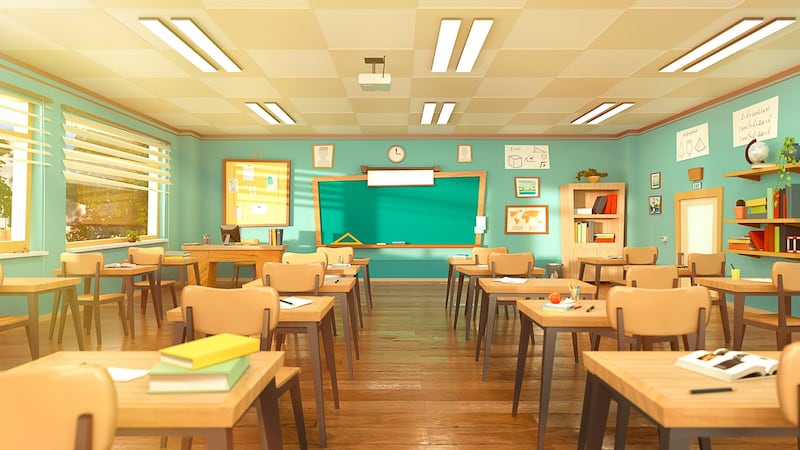The first day of "big school" will be like no other for those starting on Monday. That was the case not only for the 22 junior infants who on Friday started in Durrow National School and their parents, but also for the Co Offaly school itself.

They were the only children going in when the school outside Tullamore reopened on Friday, as the rest of the 210 pupils aren’t returning until Monday.
The “newbies” were scheduled to arrive in four groups at staggered times, said principal Frank Kelly, and there was a chance for parents to take photographs as their little ones settled into the classroom. The school was doing this because “once the Monday comes, it’s a no-go zone for parents”.
No admission without appointment is just one of the changes parents everywhere are going to have to live with as children return to school. A more welcome feature of pandemic primary-school teaching at this school, and many others, will be the absence of homework, as children will be leaving their books in the classroom.
The reopening of schools nearly six months after they closed so suddenly on March 12th is momentous, not just for the pupils and their parents, but for the whole country.
As Kelly puts it: “We have to make it work. It’s a fundamental of our society to have children in school and their parents at work.”
The immediate priorities are socialising, routine and safety. He is not worried about pupils’ academic progress, as he is “always in awe of children and how resilient they are. Once we train them on day one, they will all obey the rules of sanitisation and they will be anxious to get to work.”
Parents are equally keen that their children get back to school normality and most never want to hear the word “home-schooling” again. But despite relief at the prospect, there is anxiety too – for individual children, parents and teachers.

"Change causes anxiety and worry and we have to work to support each other," says Pairic Clerkin, chief executive of the Irish Primary Principals' Network (IPPN). Everybody would have preferred the Department of Education's guidelines for reopening earlier, he acknowledges, but there was a significant financial package that had to be negotiated.
Most schools have been working flat out to prepare the premises and policies for reopening. But we’re at the point now where the partnership between home and school has never been so crucial.
“At the end of the day there are two real objectives: first to get children back into school safely and second to minimise the risk of the virus getting into the school,” says Clerkin. “If we don’t work as a community, we increase risk.”
Stricter illness policies will be problematic for all. Just as staff can no longer come to work with symptoms that could be signs of Covid-19, so must parents keep their children home in similar circumstances, no matter how inconvenient.
The Department of Education has prepared "welcome back" information specifically for pupils and parents, with a big focus on the wellbeing of students and supporting their settling in. Schools are being asked to share the material with their families and you should also find it on gov.ie/backtoschool.
Barnardos has also put tip sheets for both children and parents for the return to school on its website. While this is general advice, chief executive Suzanne Connolly tells The Irish Times she is concerned about children living in particularly difficult family circumstances, such as parents going through an acrimonious separation, or if somebody has lost their job or where a family member has an underlying health condition. "For people living in those sort of situations, things are more complex and it is important they seek support," she stresses, be it from the charity's own parents' helpline (1800 910 123), or other resources, such as Parentline (1890 927 277).
Here are seven essential points for parents of primary school children in the countdown to reopening:
1) Look to specific guidance from your child’s school
Every primary school is working from the roadmap for the reopening of schools that was published by the Department of Education and Skills on July 26th and which has been updated since. However, exactly how requirements and recommendations can be implemented will vary from school to school, taking in factors such as the nature of the building, class sizes, school policies, location etc.
That is why parents need to inform themselves through communication from their children’s own school and then prepare their children for the changes. What you hear through friends or family, or the media, may not apply in your local school.
For instance, schools are required to implement social distancing as best as they can but the recommended one-metre space between each child is not going to be possible in many instances. In those situations, children should be put into pods and those pods kept a metre apart.
The department recommends a two-prong approach to physical distancing: “increasing separation, decreasing interaction”. The latter will be a challenge to teaching practice, says Clerkin. However, he believes every teacher will ensure their classroom “is a normal environment to the best of their ability for the children. Teachers will be interacting.”
In an update to the roadmap, primary school teachers, but not their pupils, are required to use face coverings where they cannot maintain two-metre distancing. Realistically, it’s not going to be possible for teachers to stay that far apart at all times, so children can expect to see their teachers wearing a clear shield or mask – or even both.
2) Children need to know school will be different
"Kids thrive when they can anticipate with certainty what something is going to be like," says psychotherapist Joanna Fortune, author of, 15 Minute Parenting. "That predictability brings a sense of safety and security."
However, she believes reopening information has been very late in coming, making it difficult for parents to give clarity to children and raising the tension around going back to school.
At the time of writing, with just over two weeks to go, Anna Dobson has yet to hear from her sons’ school in Co Wicklow, bar the fact that it will be reopening on September 1st. “I think every parent just wants all the children back at school; the home-schooling was a bit of a nightmare for everyone,” she says. Her sons, Rhys, Sonny and Archie, are going into sixth, fourth and second class respectively at Carysfort National School in Avoca.
As a single mother running her own shop, Tweed in the Valley, on Gorey’s Main Street in Co Wexford, she is not sure how she would cope if schools are forced to close again or had to stagger days for different ages.
Edel Horan, whose children are going into senior infants and first class at Modeligo national school in Dungarvan, Co Waterford, says they “are both excited and surprisingly calm about it”.
For her part, having found home-schooling of Alex and Ruby “a mixture of challenging and inspiring all at once”, she is hoping for a smooth transition back. She is also keen that things will be normal within the classroom, “as the early years are critical for learning the basics”.
Fortune encourages parents to be “supremely confident and positive” with their children about going back. But “be mindful that they are not going back to the school environment that they left”.
With younger children, Fortune says “play it out”, using dolls or miniature figures to talk about, for example, waiting in a socially distanced line to leave parents at the gate. For older children, from eight onwards, she suggests role play and making up a news bulletin about new procedures.

3) It will be different for parents too
Schools are being asked to stagger drop-off and collection times for different classes and this is only going to work if parents stick to the slots they’re given. This will require households to organise themselves accordingly and may mean waiting around with siblings if they are being admitted and discharged at different times.
Parents will also need to act responsibly about social distancing at the school gate and accept the day of “walk ins” are over for the time being.
If you haven’t already started a new home routine, particularly in relation to bedtimes, you still have time for a trial run in getting everybody up, washed, dressed, fed and packed to go by the new morning deadline that school will bring. “When you’re at the door, take them for a walk instead,” says Fortune. “It’s a long time since we have all had to run that gauntlet of get up and get out of the house by a certain time.”
Partnership between home and school in children's education has never been more important, says Aine Lynch of the National Parents' Council, Primary. She urges parents to inform teachers of any significant events or developments in their children's lives since March.
The handover from last year’s teacher to a child’s new teacher is always important at the beginning of the year, says Clerkin, as that teacher gets to know the new class over the coming weeks. But he recognises that developing a relationship with parents is going to be more difficult, as parent-teacher interaction will be minimised. “Some of that may have to happen on the phone, but it is very important for parents and teachers to communicate,” he adds.
4) Anxiety among children – and parents – needs to be addressed
Returning to primary school can cause anxiety for children and parents at the best of times, but none more so than in the midst of a pandemic when children have been at home for almost six months, says clinical psychologist and NUIG lecturer Dr Malie Coyne.
“Anxieties around how your child will reintegrate into school life may be rife, as well as concerns over their safety and the uncertainty of what school life will bring. This is totally understandable, which is why bringing kindness to difficult feelings is important.”
Coyne says she wrote her recently published book, Love in, Love Out: A compassionate approach to parenting your anxious child, to help parents understand the crucial role they play in modelling soothing and calm (Love in), to enable them to help their child feel safe, understood and empowered to face their fears (Love out).
Her SAFE approach advocates:
Self-care: If your child is anxious, pause and bring your awareness to how you feel, breathe in kindness and breathe out calm before responding to their need. Reflecting on how you feel gives you choices in how to react. Try to see your child's anxiety as an opportunity to connect with them.
Anchoring: Recognise your role as your child's anchor in helping them to feel safe and secure. Before school, practise "shaking on purpose" with your child (ie making noises jumping up and down), which will release any built-up tension on the first day. Create a "soothing box" of toys (eg squishies, kaleidoscope, shaker) to engage your child's senses on the way to school.
Feeling felt: If your child shares a worry with you, listen to their feelings and validate their experience ("You feel a bit nervous about... "). Respond warmly and unpack the source of their worry ("What part are you most worried about?"). Supporting them in their feeling is an important step in helping them to move on from it ("That sounds really tough for you").
Empowerment: Reflecting on how you feel and helping your child feel safe and connected gives them a sense of control in managing their anxiety. Empowering your child means finding a balance between empathising with their worries and encouraging them to face their fears ("I believe you can do this. You've managed tough things before and we'll work though this together"). When anxiety meets compassion, resilience emerges.
5) Anticipate behavioural and emotional regression
As children are presented with the latest of adaptations they have been forced to make since March, meet them where they’re at emotionally, advises Fortune.
If your nine-year-old starts acting like a six-year-old, parent them like a six-year-old, she says. Don’t tell them to act their age, rather give them the extra support you would give a younger child. “I think you can anticipate four to six weeks for them to make an adjustment, so there could be wobbles in that time. Don’t overly panic if your child is struggling.” However, if that persists by Halloween, then it might be time to review it.
She believes it could be more difficult for the tweens rather than the infants. There have been pro-social benefits for most younger children to have prolonged time at home with parents “because they take their emotional behavioural and social cues from their parents and siblings more than their peer group”. Although, they will have to get used to being back in a structured environment away from home.
Fortune is more concerned about those in the eight-12 age range. “For them the important hub of social development is not family; it’s peers. And they haven’t had access to peers at what is peak brain development time for them in that area. Those kids are tending to manifest more with the wobbles than the little ones.”
However, most of them will adapt fairly quickly, she adds.
6) Ease the parting
Some children have loved spending their time at home with mum and/or dad and may find the return a wrench. Both Fortune and Barnardos recommend using “transitional objects” for comfort.
Maybe a key-ring with a photo, a piece of a mother’s scarf or a note in the lunch-box. Fortune suggests a parent can draw a heart on his or her wrist and on the wrist of the child and rub them both to “charge them up with love” before the start of the school day. Later, the child can rub the heart for comfort. “There are little things you can do that say to them ‘you can hold me in mind and I am holding you in mind’,” she adds.
7) If you want or need an alternative to reopened schools ...
You could formalise home-schooling. The Home Education Network Ireland says it has registered three times as many new members during last month than it did in July 2019 and the rate of inquiries has risen from one or two a week to that number each day.
If you are opting to home-school a child aged between six and 16, you must contact the Educational Welfare Services of Tusla, the Child and Family Agency (01-771 8638) and inform them that you intend to home-educate. You will have to complete an assessment process before you can be officially registered and the school is required to hold a place for your child until Tusla informs them that he/she is confirmed as being home-schooled.
There is plenty of information on the HEN website, where you can find details of volunteers near you who are ready to offer advice and share details of local meet-ups.
“There is already a very collaborative and dynamic home education community right across Ireland,” says Cora McCauley of HEN. “With new families set to join, the opportunities for broadening our approaches to all types of education and learning looks set to increase.”

















